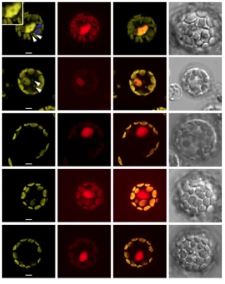
Gendron Lab members Chin-Mei Lee, Man-Wah Li, Ann Feke, Wei Liu, Adam M. Saffer & Joshua M. Gendron publish ” Gigantea recruits the UBP12 and UBP13 deubiquitylases to regulate accumulation of the ZTL photoreceptor complex”. The introduction is shown below. The full article may be viewed by clicking the link included in the article title above.
Introduction
Circadian clocks in all organisms rely on photoreceptors to sense light and entrain the central oscillator. The exact timing of the light-to-dark transition (dusk) is especially important for plants, as this indicates the length of the day and provides seasonal timing information necessary for the adjustment of plant developmental processes1,2,3,4,5,6,7,8. One way that Arabidopsis senses the end of the day is by using a unique photoreceptor called ZEITLUPE (ZTL) to control the stability of circadian clock transcription factors differentially in the light and the dark9. ZTL contains an N-terminal light-oxygen-voltage sensing (LOV) domain, which senses blue light. Adjacent to the LOV domain are the F-box domain, which allows ZTL to function as an E3 ubiquitin ligase, and a Kelch-repeat domain. ZTL mediates degradation of transcription factors that are at the core of the plant circadian clock, including TIMING OF CAB2 EXPRESSION 1, PSEUDO-RESPONSE REGULATOR 5, and CCA1 HIKING EXPEDITION (TOC1, PRR5, and CHE)10,11,12,13,14,15. In the light, ZTL accumulates to high levels but is unable to mediate degradation of the clock transcription factors16,17. The accumulation of ZTL protein during the day is dependent on interaction with the co-chaperone protein GIGANTEA (GI)18,19,20. GI interacts with ZTL through the LOV domain in the light and dissociates from ZTL in the dark, allowing ZTL to mediate degradation of its target proteins and then be degraded by the ubiquitin proteasome system, likely through autocatalytic activity10,11,16,17,18,21,22. One of the roles of GI is to recruit HSP70/HSP90 for maturation of the ZTL protein in the light, but ZTL is unable to mediate ubiquitylation and degradation of target proteins until dark10,11,12,19,23. It was proposed that GI can promote maturation of ZTL and block or counteract ZTL activity; however, this second role for GI has not been investigated in depth12,23.
We previously identified ZTL-interacting proteins using immunoprecipitation followed by mass spectrometry (IP-MS) with a “decoy” ZTL that lacks E3 ubiquitin ligase activity and stably binds interacting proteins14. We identified UBIQUITIN-SPECIFIC PROTEASE 12 and 13 (UBP12 and UBP13) as high-confidence ZTL-interacting proteins, which were shown previously to have an unspecified role in clock function14,24. UBP12 and UBP13 also interact with GI in IP-MS experiments25, suggesting that either the UBPs interact with ZTL and GI independently or that ZTL, GI, and the UBPs exist together in a complex. UBP12 and UBP13 are closely related deubiquitylating enzymes that can cleave lysine 48-linked mono- or poly-ubiquitin from substrates24,26, interestingly, a biochemical role opposite to that of ZTL. In addition to regulating the circadian clock, they are also involved in flowering time, pathogen defense, root differentiation, and hormone signaling26,27,28,29,30.
Here, we show that UBP12 and UBP13 interact with the ZTL photoreceptor complex in a GI-dependent manner. Supporting this idea, genetic analyses show that UBP12 and UBP13 impact clock function through the same genetic pathway as ZTL and GI. Finally, we demonstrate that UBP12 and UBP13 are necessary for the proper daily accumulation of ZTL, GI, and TOC1 proteins. These results support the idea that in plants the communication of end-of-day light information relies on a photoreceptor complex that contains both ubiquitin conjugation activity and ubiquitin deconjugation activity.